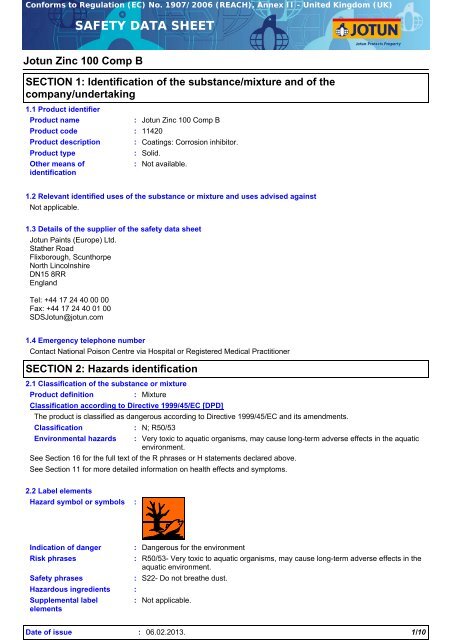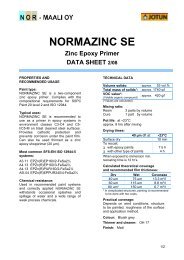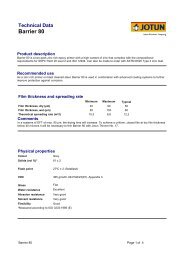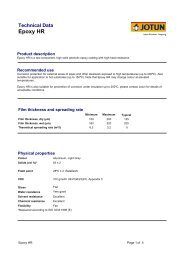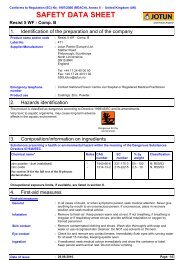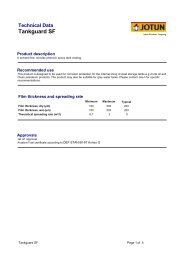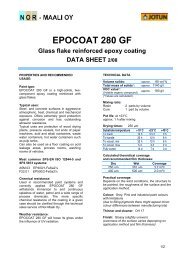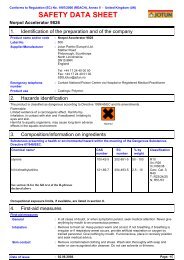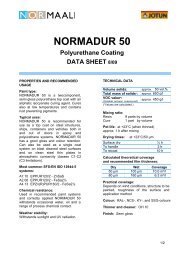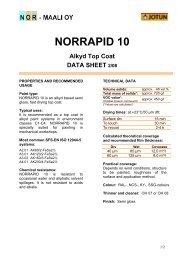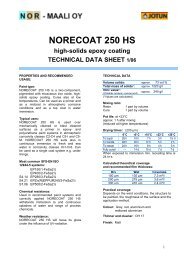Jotun Zinc 100 Comp B
Jotun Zinc 100 Comp B
Jotun Zinc 100 Comp B
Create successful ePaper yourself
Turn your PDF publications into a flip-book with our unique Google optimized e-Paper software.
Conforms to Regulation (EC) No. 1907/2006 (REACH), Annex II - United Kingdom (UK)<br />
SAFETY DATA SHEET<br />
<strong>Jotun</strong> <strong>Zinc</strong> <strong>100</strong> <strong>Comp</strong> B<br />
SECTION 1: Identification of the substance/mixture and of the<br />
company/undertaking<br />
1.1 Product identifier<br />
Product name :<br />
Product code :<br />
Product description :<br />
Product type :<br />
Other means of<br />
:<br />
identification<br />
<strong>Jotun</strong> <strong>Zinc</strong> <strong>100</strong> <strong>Comp</strong> B<br />
11420<br />
Coatings: Corrosion inhibitor.<br />
Solid.<br />
Not available.<br />
1.2 Relevant identified uses of the substance or mixture and uses advised against<br />
Not applicable.<br />
1.3 Details of the supplier of the safety data sheet<br />
<strong>Jotun</strong> Paints (Europe) Ltd.<br />
Stather Road<br />
Flixborough, Scunthorpe<br />
North Lincolnshire<br />
DN15 8RR<br />
England<br />
Tel: +44 17 24 40 00 00<br />
Fax: +44 17 24 40 01 00<br />
SDS<strong>Jotun</strong>@jotun.com<br />
1.4 Emergency telephone number<br />
Contact National Poison Centre via Hospital or Registered Medical Practitioner<br />
SECTION 2: Hazards identification<br />
2.1 Classification of the substance or mixture<br />
Product definition<br />
: Mixture<br />
Classification according to Directive 1999/45/EC [DPD]<br />
The product is classified as dangerous according to Directive 1999/45/EC and its amendments.<br />
Classification : N; R50/53<br />
Environmental hazards : Very toxic to aquatic organisms, may cause long-term adverse effects in the aquatic<br />
environment.<br />
See Section 16 for the full text of the R phrases or H statements declared above.<br />
See Section 11 for more detailed information on health effects and symptoms.<br />
2.2 Label elements<br />
Hazard symbol or symbols<br />
:<br />
Indication of danger :<br />
Risk phrases<br />
Safety phrases<br />
Hazardous ingredients<br />
Supplemental label<br />
elements<br />
:<br />
:<br />
:<br />
Dangerous for the environment<br />
R50/53- Very toxic to aquatic organisms, may cause long-term adverse effects in the<br />
aquatic environment.<br />
S22- Do not breathe dust.<br />
: Not applicable.<br />
Date of issue : 06.02.2013.<br />
1/10
Conforms to Regulation (EC) No. 1907/2006 (REACH), Annex II - United Kingdom (UK)<br />
<strong>Jotun</strong> <strong>Zinc</strong> <strong>100</strong> <strong>Comp</strong> B<br />
SECTION 2: Hazards identification<br />
2.3 Other hazards<br />
Other hazards which do not<br />
result in classification<br />
:<br />
Not available.<br />
SECTION 3: <strong>Comp</strong>osition/information on ingredients<br />
Substance/mixture<br />
Product/ingredient<br />
name<br />
:<br />
Mixture<br />
Identifiers<br />
zinc EC: 231-175-3<br />
CAS: 7440-66-6<br />
zinc oxide REACH #: 01-<br />
2119463881-32<br />
EC: 215-222-5<br />
CAS: 1314-13-2<br />
Index: 030-013-00-7<br />
% 67/548/EEC Regulation (EC) No. Type<br />
1272/2008 [CLP]<br />
>=90 N; R50/53 Aquatic Acute 1, H400<br />
Aquatic Chronic 1,<br />
H410<br />
2,5-25 N; R50/53 Aquatic Acute 1, H400<br />
See Section 16 for<br />
the full text of the R-<br />
phrases declared<br />
above.<br />
Classification<br />
Aquatic Chronic 1,<br />
H410<br />
See Section 16 for<br />
the full text of the H<br />
statements declared<br />
above.<br />
[1] [2] -<br />
[1] -<br />
Notes<br />
There are no additional ingredients present which, within the current knowledge of the supplier and in the concentrations<br />
applicable, are classified as hazardous to health or the environment, are PBTs or vPvBs or have been assigned a<br />
workplace exposure limit and hence require reporting in this section.<br />
Occupational exposure limits, if available, are listed in Section 8.<br />
SECTION 4: First aid measures<br />
4.1 Description of first aid measures<br />
General<br />
: In all cases of doubt, or when symptoms persist, seek medical attention. Never give<br />
anything by mouth to an unconscious person. If unconscious, place in recovery<br />
position and seek medical advice.<br />
Inhalation<br />
: Remove to fresh air. Keep person warm and at rest. If not breathing, if breathing is<br />
irregular or if respiratory arrest occurs, provide artificial respiration or oxygen by<br />
trained personnel.<br />
Skin contact<br />
: Remove contaminated clothing and shoes. Wash skin thoroughly with soap and water<br />
or use recognised skin cleanser. Do NOT use solvents or thinners.<br />
Eye contact<br />
: Check for and remove any contact lenses. Immediately flush eyes with running water<br />
for at least 15 minutes, keeping eyelids open. Seek immediate medical attention.<br />
Ingestion<br />
Protection of first-aiders<br />
:<br />
If swallowed, seek medical advice immediately and show the container or label. Keep<br />
person warm and at rest. Do not induce vomiting.<br />
: No action shall be taken involving any personal risk or without suitable training. It may<br />
be dangerous to the person providing aid to give mouth-to-mouth resuscitation.<br />
4.2 Most important symptoms and effects, both acute and delayed<br />
Potential acute health effects<br />
Eye contact<br />
: No known significant effects or critical hazards.<br />
Inhalation<br />
: No known significant effects or critical hazards.<br />
Skin contact<br />
: No known significant effects or critical hazards.<br />
Ingestion<br />
: No known significant effects or critical hazards.<br />
Over-exposure signs/symptoms<br />
Eye contact<br />
Inhalation<br />
Skin contact<br />
: No specific data.<br />
:<br />
:<br />
No specific data.<br />
No specific data.<br />
Date of issue : 06.02.2013.<br />
2/10
Conforms to Regulation (EC) No. 1907/2006 (REACH), Annex II - United Kingdom (UK)<br />
<strong>Jotun</strong> <strong>Zinc</strong> <strong>100</strong> <strong>Comp</strong> B<br />
SECTION 4: First aid measures<br />
Ingestion<br />
: No specific data.<br />
4.3 Indication of any immediate medical attention and special treatment needed<br />
Notes to physician<br />
Specific treatments<br />
:<br />
:<br />
Treat symptomatically. Contact poison treatment specialist immediately if large<br />
quantities have been ingested or inhaled.<br />
No specific treatment.<br />
SECTION 5: Firefighting measures<br />
5.1 Extinguishing media<br />
Suitable extinguishing<br />
media<br />
Unsuitable extinguishing<br />
media<br />
:<br />
:<br />
Recommended: alcohol-resistant foam, CO 2 blanket, water spray or mist.<br />
Do not use water jet.<br />
Do not use inert gas under high pressure (e.g. CO2).<br />
5.2 Special hazards arising from the substance or mixture<br />
Hazards from the<br />
substance or mixture<br />
:<br />
No specific fire or explosion hazard.<br />
Hazardous thermal<br />
decomposition products<br />
:<br />
Decomposition products may include the following materials:<br />
metal oxide/oxides<br />
5.3 Advice for firefighters<br />
Special protective actions<br />
for fire-fighters<br />
Special protective<br />
equipment for fire-fighters<br />
:<br />
:<br />
Promptly isolate the scene by removing all persons from the vicinity of the incident if<br />
there is a fire. No action shall be taken involving any personal risk or without suitable<br />
training. This material is very toxic to aquatic organisms. Fire water contaminated<br />
with this material must be contained and prevented from being discharged to any<br />
waterway, sewer or drain.<br />
Fire-fighters should wear appropriate protective equipment and self-contained<br />
breathing apparatus (SCBA) with a full face-piece operated in positive pressure<br />
mode. Clothing for fire-fighters (including helmets, protective boots and gloves)<br />
conforming to European standard EN 469 will provide a basic level of protection for<br />
chemical incidents.<br />
SECTION 6: Accidental release measures<br />
6.1 Personal precautions, protective equipment and emergency procedures<br />
For non-emergency<br />
personnel<br />
For emergency responders :<br />
:<br />
No action shall be taken involving any personal risk or without suitable training.<br />
Evacuate surrounding areas. Keep unnecessary and unprotected personnel from<br />
entering. Do not touch or walk through spilt material. Provide adequate ventilation.<br />
Wear appropriate respirator when ventilation is inadequate. Put on appropriate<br />
personal protective equipment.<br />
If specialised clothing is required to deal with the spillage, take note of any information<br />
in Section 8 on suitable and unsuitable materials. See also Section 8 for additional<br />
information on hygiene measures.<br />
6.2 Environmental<br />
precautions<br />
:<br />
Avoid dispersal of spilt material and runoff and contact with soil, waterways, drains<br />
and sewers. Inform the relevant authorities if the product has caused environmental<br />
pollution (sewers, waterways, soil or air). Water polluting material. May be harmful to<br />
the environment if released in large quantities.<br />
6.3 Methods and materials for containment and cleaning up<br />
Small spill :<br />
Large spill :<br />
Move containers from spill area. Vacuum or sweep up material and place in a<br />
designated, labelled waste container. Dispose of via a licensed waste disposal<br />
contractor.<br />
Move containers from spill area. Approach the release from upwind. Prevent entry<br />
into sewers, water courses, basements or confined areas. Vacuum or sweep up<br />
material and place in a designated, labelled waste container. Dispose of via a<br />
licensed waste disposal contractor.<br />
Date of issue : 06.02.2013.<br />
3/10
Conforms to Regulation (EC) No. 1907/2006 (REACH), Annex II - United Kingdom (UK)<br />
<strong>Jotun</strong> <strong>Zinc</strong> <strong>100</strong> <strong>Comp</strong> B<br />
SECTION 6: Accidental release measures<br />
6.4 Reference to other<br />
sections<br />
:<br />
See Section 1 for emergency contact information.<br />
See Section 8 for information on appropriate personal protective equipment.<br />
See Section 13 for additional waste treatment information.<br />
SECTION 7: Handling and storage<br />
The information in this section contains generic advice and guidance. The list of Identified Uses in Section 1 should be<br />
consulted for any available use-specific information provided in the Exposure Scenario(s).<br />
7.1 Precautions for safe handling<br />
Precautions should be taken to prevent the formation of dusts in concentrations above flammable, explosive or<br />
occupational exposure limits.<br />
Electrical equipment and lighting should be protected to appropriate standards to prevent dust coming into contact with<br />
hot surfaces, sparks or other ignition sources.<br />
To dissipate static electricity during transfer, earth drum and connect to receiving container with bonding strap. Operators<br />
should wear antistatic footwear and clothing and floors should be of the conducting type.<br />
Keep away from heat, sparks and flame.<br />
Avoid contact with skin and eyes. Avoid the inhalation of dust, particulates, spray or mist arising from the application of<br />
this preparation. Avoid inhalation of dust from sanding.<br />
Eating, drinking and smoking should be prohibited in areas where this material is handled, stored and processed.<br />
Put on appropriate personal protective equipment (see Section 8).<br />
Always keep in containers made from the same material as the original one.<br />
<strong>Comp</strong>ly with the health and safety at work laws.<br />
When operators, whether spraying or not, have to work inside the spray booth, ventilation is unlikely to be sufficient to<br />
control particulates and solvent vapour in all cases. In such circumstances they should wear a compressed air-fed<br />
respirator during the spraying process and until such time as the particulates and solvent vapour concentration has fallen<br />
below the exposure limits.<br />
7.2 Conditions for safe storage, including any incompatibilities<br />
Store in accordance with local regulations.<br />
Additional information on storage conditions<br />
Observe label precautions. Store in a dry, cool and well-ventilated area. Keep away from heat and direct sunlight.<br />
Keep container tightly closed.<br />
Keep away from sources of ignition. No smoking. Prevent unauthorised access. Containers that have been opened must<br />
be carefully resealed and kept upright to prevent leakage.<br />
7.3 Specific end use(s)<br />
Recommendations :<br />
Industrial sector specific :<br />
solutions<br />
Not available.<br />
Not available.<br />
SECTION 8: Exposure controls/personal protection<br />
The information in this section contains generic advice and guidance. The list of Identified Uses in Section 1 should be<br />
consulted for any available use-specific information provided in the Exposure Scenario(s).<br />
8.1 Control parameters<br />
Occupational exposure limits<br />
Dust Limit : 10 mg/m³ (TWA of total inhalable dust) and 4 mg/m³ (TWA of respirable)<br />
Product/ingredient name<br />
Exposure limit values<br />
zinc EH40-MEL (United Kingdom (UK), 2002).<br />
STEL: 10 mg/m³ 15 minute(s).<br />
TWA: 5 mg/m³ 8 hour(s).<br />
Date of issue : 06.02.2013.<br />
4/10
Conforms to Regulation (EC) No. 1907/2006 (REACH), Annex II - United Kingdom (UK)<br />
<strong>Jotun</strong> <strong>Zinc</strong> <strong>100</strong> <strong>Comp</strong> B<br />
SECTION 8: Exposure controls/personal protection<br />
Recommended monitoring<br />
procedures<br />
Derived effect levels<br />
:<br />
If this product contains ingredients with exposure limits, personal, workplace<br />
atmosphere or biological monitoring may be required to determine the effectiveness<br />
of the ventilation or other control measures and/or the necessity to use respiratory<br />
protective equipment. Reference should be made to European Standard EN 689 for<br />
methods for the assessment of exposure by inhalation to chemical agents and<br />
national guidance documents for methods for the determination of hazardous<br />
substances.<br />
Product/ingredient name Type Exposure Value Population Effects<br />
zinc oxide DNEL Long term Dermal 83 mg/kg Workers Systemic<br />
bw/day<br />
DNEL Long term 5 mg/m³ Workers Systemic<br />
Inhalation<br />
DNEL Long term Dermal 83 mg/kg Consumers Systemic<br />
bw/day<br />
DNEL Long term 2,5 mg/m³ Consumers Systemic<br />
Inhalation<br />
DNEL Long term Oral 0,83 mg/kg<br />
bw/day<br />
Consumers Systemic<br />
Predicted effect concentrations<br />
Product/ingredient name Type <strong>Comp</strong>artment Detail Value Method Detail<br />
zinc oxide PNEC Fresh water 20,6 μg/l -<br />
PNEC Marine 6,1 μg/l -<br />
PNEC Sewage Treatment 52 μg/l -<br />
Plant<br />
PNEC Fresh water sediment 117,8 mg/kg dwt -<br />
PNEC Marine water sediment 56,5 mg/kg dwt -<br />
PNEC Soil 35,6 mg/kg dwt -<br />
8.2 Exposure controls<br />
Appropriate engineering<br />
controls<br />
Eye/face protection<br />
Skin protection<br />
Hand protection<br />
: No special ventilation requirements. Good general ventilation should be sufficient to<br />
control worker exposure to airborne contaminants. If this product contains<br />
ingredients with exposure limits, use process enclosures, local exhaust ventilation or<br />
other engineering controls to keep worker exposure below any recommended or<br />
statutory limits.<br />
Individual protection measures<br />
Hygiene measures : Wash hands, forearms and face thoroughly after handling chemical products, before<br />
eating, smoking and using the lavatory and at the end of the working period.<br />
Appropriate techniques should be used to remove potentially contaminated clothing.<br />
Wash contaminated clothing before reusing. Ensure that eyewash stations and<br />
safety showers are close to the workstation location.<br />
:<br />
:<br />
Safety eyewear complying with an approved standard should be used when a risk<br />
assessment indicates this is necessary to avoid exposure to liquid splashes, mists or<br />
dusts.<br />
For prolonged or repeated handling, use the following type of gloves: gloves: nitrile.<br />
Barrier creams may help to protect the exposed areas of the skin but should not be<br />
applied once exposure has occurred.<br />
For prolonged or repeated handling, use the following type of gloves:<br />
Body protection :<br />
Recommended, gloves(breakthrough time) > 8 hours: nitrile rubber<br />
For right choice of glove materials, with focus on chemical resistance and time of<br />
penetration, seek advice by the supplier of chemical resistant gloves.<br />
The user must check that the final choice of type of glove selected for handling this<br />
product is the most appropriate and takes into account the particular conditions of<br />
use, as included in the user's risk assessment.<br />
Personal protective equipment for the body should be selected based on the task<br />
being performed and the risks involved and should be approved by a specialist<br />
before handling this product.<br />
Date of issue : 06.02.2013.<br />
5/10
Conforms to Regulation (EC) No. 1907/2006 (REACH), Annex II - United Kingdom (UK)<br />
<strong>Jotun</strong> <strong>Zinc</strong> <strong>100</strong> <strong>Comp</strong> B<br />
SECTION 8: Exposure controls/personal protection<br />
Other skin protection<br />
Respiratory protection :<br />
Environmental exposure<br />
controls<br />
:<br />
Appropriate footwear and any additional skin protection measures should be selected<br />
based on the task being performed and the risks involved and should be approved by<br />
a specialist before handling this product.<br />
If workers are exposed to concentrations above the exposure limit, they must use<br />
appropriate, certified respirators. If dust is generated and ventilation is inadequate,<br />
use respirator that will protect against dust/mist. (FFP2 / N95).<br />
: Emissions from ventilation or work process equipment should be checked to ensure<br />
they comply with the requirements of environmental protection legislation. In some<br />
cases, fume scrubbers, filters or engineering modifications to the process equipment<br />
will be necessary to reduce emissions to acceptable levels.<br />
SECTION 9: Physical and chemical properties<br />
9.1 Information on basic physical and chemical properties<br />
Appearance<br />
Physical state<br />
Colour<br />
:<br />
:<br />
Solid.<br />
Grey.<br />
Odour<br />
: Odourless.<br />
Odour threshold<br />
: Not available.<br />
pH<br />
: Not applicable.<br />
Melting point/freezing point<br />
Initial boiling point and boiling<br />
range<br />
:<br />
:<br />
Not available.<br />
Not available.<br />
Flash point<br />
Evaporation rate<br />
Flammability (solid, gas)<br />
Burning time<br />
Burning rate<br />
Upper/lower flammability or<br />
explosive limits<br />
: Not available.<br />
: Not available.<br />
: Not available.<br />
: Not available.<br />
: Not available.<br />
:<br />
Vapour pressure<br />
Vapour density<br />
Relative density<br />
Solubility(ies)<br />
Partition coefficient: n-<br />
octanol/water<br />
:<br />
:<br />
:<br />
:<br />
:<br />
Not available.<br />
Not available.<br />
7.14 g/cm 3<br />
Insoluble in the following materials: cold water and hot water.<br />
Not available.<br />
Auto-ignition temperature : Not available.<br />
Decomposition temperature<br />
Viscosity<br />
Explosive properties<br />
Oxidising properties :<br />
: Not available.<br />
:<br />
:<br />
Not available.<br />
Not available.<br />
Not available.<br />
9.2 Other information<br />
No additional information.<br />
SECTION 10: Stability and reactivity<br />
10.1 Reactivity : No specific test data related to reactivity available for this product or its ingredients.<br />
10.2 Chemical stability : The product is stable.<br />
10.3 Possibility of hazardous<br />
reactions<br />
10.4 Conditions to avoid : No specific data.<br />
10.5 Incompatible materials : No specific data.<br />
: Under normal conditions of storage and use, hazardous reactions will not occur.<br />
Date of issue : 06.02.2013.<br />
6/10
Conforms to Regulation (EC) No. 1907/2006 (REACH), Annex II - United Kingdom (UK)<br />
<strong>Jotun</strong> <strong>Zinc</strong> <strong>100</strong> <strong>Comp</strong> B<br />
SECTION 10: Stability and reactivity<br />
10.6 Hazardous<br />
decomposition products<br />
SECTION 11: Toxicological information<br />
:<br />
Under normal conditions of storage and use, hazardous decomposition products<br />
should not be produced.<br />
11.1 Information on toxicological effects<br />
There are no data available on the preparation itself. The preparation has been assessed following the conventional<br />
method of the Dangerous Preparations Directive 1999/45/EC and classified for toxicological hazards accordingly. See<br />
sections 2 and 15 for details.<br />
Coating powders can cause localised skin irritation in folds of the skin or under tight clothing. Handling and/or processing<br />
of this material may generate a dust which can cause mechanical irritation of the eyes, skin, nose and throat. Repeated<br />
inhalation of dust can produce varying degrees of respiratory irritation or lung damage. Swallowing may cause nausea,<br />
diarrhoea, vomiting and gastro-intestinal irritation.<br />
Inhalation of zinc fumes may induce influenza (zinc fever), which usually may last for two days.<br />
SECTION 12: Ecological information<br />
12.1 Toxicity<br />
Product/ingredient name<br />
Result<br />
Species<br />
Exposure<br />
zinc Acute LC50 68 ug/L Fresh water Daphnia - Daphnia magna - <strong>100</strong>0 ppm Fresh water Daphnia - Daphnia magna -
Conforms to Regulation (EC) No. 1907/2006 (REACH), Annex II - United Kingdom (UK)<br />
<strong>Jotun</strong> <strong>Zinc</strong> <strong>100</strong> <strong>Comp</strong> B<br />
SECTION 13: Disposal considerations<br />
The information in this section contains generic advice and guidance. The list of Identified Uses in Section 1 should be<br />
consulted for any available use-specific information provided in the Exposure Scenario(s).<br />
13.1 Waste treatment methods<br />
Do not allow to enter drains or watercourses. Material and/or container must be disposed of as hazardous waste.<br />
European waste catalogue<br />
(EWC)<br />
:<br />
08 01 11* Waste paint and varnish containing organic solvents or other dangerous<br />
substances. If this product is mixed with other wastes, this code may no longer apply. If<br />
mixed with other wastes, the appropriate code should be assigned. For further<br />
information, contact your local waste authority.<br />
SECTION 14: Transport information<br />
Transport within user’s premises: always transport in closed containers that are upright and secure. Ensure that<br />
persons transporting the product know what to do in the event of an accident or spillage.<br />
Transport in accordance with ADR/RID, IMDG/IMO and ICAO/IATA and national regulation.<br />
Remarks<br />
These zinc types have been tested according to the criteria for classes 4.1, 4.2 and 4.3. The testresults shows that<br />
these types do not meet the criterias for classifying in class 4.1, 4.2, 4.3 : BAM, 2005 Report II.2-916/04.<br />
International transport regulations<br />
14.1 UN number<br />
14.2 UN proper shipping<br />
name<br />
14.3 Transport hazard<br />
class(es)<br />
:<br />
:<br />
:<br />
3077<br />
Environmentally hazardous substance, solid, n.o.s. (zinc, zinc oxide). Marine pollutant<br />
(zinc, zinc oxide)<br />
9<br />
Marking<br />
14.4 Packing group<br />
14.5 Environmental hazards<br />
14.6 Special precautions<br />
for user<br />
Additional information<br />
ADR / RID<br />
IMDG<br />
14.7 Transport in bulk<br />
according to Annex II of<br />
MARPOL 73/78 and the IBC<br />
Code<br />
: The environmental hazardous / marine pollutant mark is only applicable for packages<br />
containing more than 5 litres for liquids and 5 kg for solids.<br />
:<br />
:<br />
:<br />
III<br />
Yes.<br />
Not available.<br />
: Tunnel restriction code: (E)<br />
Hazard identification number: 90<br />
: Emergency schedules (EmS)<br />
F-A, S-F<br />
: Not available.<br />
SECTION 15: Regulatory information<br />
15.1 Safety, health and environmental regulations/legislation specific for the substance or mixture<br />
EU Regulation (EC) No. 1907/2006 (REACH)<br />
Annex XIV - List of substances subject to authorisation<br />
Substances of very high concern<br />
None of the components are listed.<br />
Annex XVII - Restrictions<br />
on the manufacture,<br />
placing on the market and<br />
use of certain dangerous<br />
substances, mixtures and<br />
articles<br />
Other EU regulations<br />
:<br />
Not applicable.<br />
Date of issue : 06.02.2013.<br />
8/10
Conforms to Regulation (EC) No. 1907/2006 (REACH), Annex II - United Kingdom (UK)<br />
<strong>Jotun</strong> <strong>Zinc</strong> <strong>100</strong> <strong>Comp</strong> B<br />
SECTION 15: Regulatory information<br />
Europe inventory<br />
: Not determined.<br />
Black List Chemicals : Not listed<br />
Priority List Chemicals : Listed<br />
Integrated pollution : Listed<br />
prevention and control list<br />
(IPPC) - Air<br />
Integrated pollution<br />
prevention and control list<br />
(IPPC) - Water<br />
International regulations<br />
Chemical Weapons<br />
Convention List Schedule I<br />
Chemicals<br />
Chemical Weapons<br />
Convention List Schedule II<br />
Chemicals<br />
Chemical Weapons<br />
Convention List Schedule III<br />
Chemicals<br />
: Listed<br />
: Not listed<br />
: Not listed<br />
: Not listed<br />
15.2 Chemical Safety<br />
Assessment<br />
:<br />
This product contains substances for which Chemical Safety Assessments are still<br />
required.<br />
SECTION 16: Other information<br />
Indicates information that has changed from previously issued version.<br />
Abbreviations and acronyms : ATE = Acute Toxicity Estimate<br />
CLP = Classification, Labelling and Packaging Regulation [Regulation (EC) No.<br />
1272/2008]<br />
DNEL = Derived No Effect Level<br />
EUH statement = CLP-specific Hazard statement<br />
PNEC = Predicted No Effect Concentration<br />
RRN = REACH Registration Number<br />
Classification according to Regulation (EC) No. 1272/2008 [CLP/GHS]<br />
Aquatic Acute 1, H400<br />
Aquatic Chronic 1, H410<br />
Procedure used to derive the classification according to Regulation (EC) No. 1272/2008 [CLP/GHS]<br />
Classification<br />
Justification<br />
Aquatic Acute 1, H400<br />
Calculation method<br />
Aquatic Chronic 1, H410<br />
Calculation method<br />
Full text of abbreviated H<br />
statements<br />
Full text of classifications<br />
[CLP/GHS]<br />
Full text of abbreviated R<br />
phrases<br />
:<br />
:<br />
:<br />
H400 Very toxic to aquatic life.<br />
H410 Very toxic to aquatic life with long lasting effects.<br />
Aquatic Acute 1, H400 AQUATIC TOXICITY (ACUTE) - Category 1<br />
Aquatic Chronic 1, H410 AQUATIC TOXICITY (CHRONIC) - Category 1<br />
R50/53- Very toxic to aquatic organisms, may cause long-term adverse effects in the<br />
aquatic environment.<br />
Full text of classifications<br />
[DSD/DPD]<br />
Date of printing<br />
Date of issue/ Date of<br />
revision<br />
Date of previous issue<br />
Version<br />
Notice to reader<br />
:<br />
:<br />
:<br />
:<br />
:<br />
N - Dangerous for the environment<br />
06.02.2013.<br />
06.02.2013.<br />
No previous validation.<br />
1.01<br />
Date of issue : 06.02.2013.<br />
9/10
Conforms to Regulation (EC) No. 1907/2006 (REACH), Annex II - United Kingdom (UK)<br />
<strong>Jotun</strong> <strong>Zinc</strong> <strong>100</strong> <strong>Comp</strong> B<br />
SECTION 16: Other information<br />
To the best of our knowledge, the information contained herein is accurate. However, neither the above-named<br />
supplier, nor any of its subsidiaries, assumes any liability whatsoever for the accuracy or completeness of the<br />
information contained herein.<br />
Final determination of suitability of any material is the sole responsibility of the user. All materials may present<br />
unknown hazards and should be used with caution. Although certain hazards are described herein, we cannot<br />
guarantee that these are the only hazards that exist.<br />
Date of issue : 06.02.2013.<br />
10/10


